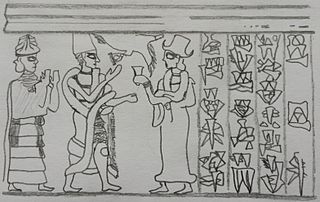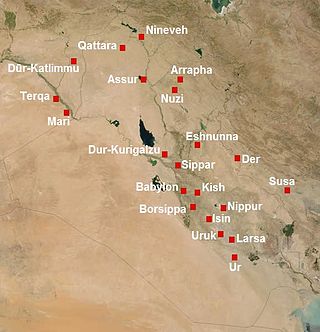This article needs additional citations for verification .(April 2019) |
| Millennium |
|---|
| 2nd millennium BC |
| Centuries |
| Decades |
| Years |
|
| Categories |
The 1760s BC was a decade lasting from January 1, 1769 BC to December 31, 1760 BC.
This article needs additional citations for verification .(April 2019) |
| Millennium |
|---|
| 2nd millennium BC |
| Centuries |
| Decades |
| Years |
|
| Categories |
The 1760s BC was a decade lasting from January 1, 1769 BC to December 31, 1760 BC.
The 18th century BC was the century that lasted from 1800 BC to 1701 BC.
The 1780s BC was a decade lasting from January 1, 1789 BC to December 31, 1780 BC.

The Old Babylonian Empire, or First Babylonian Empire, is dated to c. 1894–1595 BC, and comes after the end of Sumerian power with the destruction of the Third Dynasty of Ur, and the subsequent Isin-Larsa period. The chronology of the first dynasty of Babylonia is debated, since there is a Babylonian King List A and also a Babylonian King List B. In this chronology, the regnal years of List A are used due to their wide usage. The reign lengths given in List B are longer, generally speaking.

Yamhad (Yamḫad) was an ancient Semitic-speaking kingdom centered on Ḥalab (Aleppo) in Syria. The kingdom emerged at the end of the 19th century BC and was ruled by the Yamhad dynasty, who counted on both military and diplomacy to expand their realm. From the beginning of its establishment, the kingdom withstood the aggressions of its neighbors Mari, Qatna and the Old Assyrian Empire, and was turned into the most powerful Syrian kingdom of its era through the actions of its king Yarim-Lim I. By the middle of the 18th century BC, most of Syria minus the south came under the authority of Yamhad, either as a direct possession or through vassalage, and for nearly a century and a half, Yamhad dominated northern, northwestern and eastern Syria, and had influence over small kingdoms in Mesopotamia at the borders of Elam. The kingdom was eventually destroyed by the Hittites, then annexed by Mitanni in the 16th century BC.
The 1770s BC was a decade lasting from January 1, 1779 BC to December 31, 1770 BC.

The 1790s BC was a decade lasting from January 1, 1799 BC to December 31, 1790 BC. During this decade, the Near East was in the midst of the Middle Bronze Age.

Mari was an ancient Semitic city-state in modern-day Syria. Its remains form a tell 11 kilometers north-west of Abu Kamal on the Euphrates River western bank, some 120 kilometers southeast of Deir ez-Zor. It flourished as a trade center and hegemonic state between 2900 BC and 1759 BC. The city was built in the middle of the Euphrates trade routes between Sumer in the south and the Eblaite kingdom and the Levant in the west.

Eshnunna was an ancient Sumerian city and city-state in central Mesopotamia 12.6 miles northwest of Tell Agrab and 15 miles northwest of Tell Ishchali. Although situated in the Diyala Valley northwest of Sumer proper, the city nonetheless belonged securely within the Sumerian cultural milieu. It is sometimes, in archaeological papers, called Ashnunnak or Tuplias.

Zimri-Lim was king of Mari c. 1775–1761 BCE.

The Battle of the Vale of Siddim, also often called the War of Nine Kings or the Slaughter of Chedorlaomer, is an event in the Hebrew Bible book of Genesis 14:1–17 that occurs in the days of Abram and Lot. The Vale of Siddim was the battleground for the cities of the Jordan River plain revolting against Mesopotamian rule.

The Royal Palace of Mari was the royal residence of the rulers of the ancient kingdom of Mari in eastern Syria. Situated centrally amidst Palestine, Syria, Babylon, Levant, and other Mesopotamian city-states, Mari acted as the “middle-man” to these larger, powerful kingdoms. Both the size and grand nature of the palace demonstrate the importance of Mari during its long history, though the most intriguing feature of the palace is the nearly 25,000 tablets found within the palace rooms. The royal palace was discovered in 1935, excavated with the rest of the city throughout the 1930s, and is considered one of the most important finds made at Mari. André Parrot led the excavations and was responsible for the discovery of the city and the palace. Thousands of clay tablets were discovered through the efforts of André Bianquis, who provided archaeologists the tools to learn about, and to understand, everyday life at the palace in Mari. The discovery of the tablets also aided in the labeling of various rooms in terms of their purpose and function.
Diniktum, inscribed Di-ni-ik-tumKI, was a still unlocated middle bronze-age town often thought to be located somewhere in the Diyala Governorate of Iraq.

The Investiture of Zimri-Lim is a large colorful mural discovered at the Royal Palace of the ancient city-state of Mari in eastern Syria. The fresco, which dates back to the 18th century BC, depicts Zimri-Lim, king of Mari, receiving the rod-and-ring symbol from the goddess Ishtar. The painting was discovered in situ on its original wall located opposite the grand doorway to the podium which leads to the throne room of the palace. It was discovered by French archaeologist André Parrot during excavations at Mari in 1935–1936. The painting is now displayed at the Musée du Louvre in Paris, France.
Yarim-Lim I, also given as Yarimlim, was the second king of the ancient Amorite kingdom of Yamhad in modern-day Aleppo, Syria.
Hammurabi I is the third attested king of Yamhad (Halab).

The Yamhad dynasty was an ancient Amorite royal family founded in c. 1810 BC by Sumu-Epuh of Yamhad who had his capital in the city of Aleppo. Started as a local dynasty, the family expanded its influence through the actions of its energetic ruler Yarim-Lim I who turned it into the most influential family in the Levant through both diplomatic and military tools. At its height the dynasty controlled most of northern Syria and the modern Turkish province of Hatay with a cadet branch ruling in the city of Alalakh.

Ibal pi’el II was a king of the city kingdom of Eshnunna in ancient Mesopotamia. He reigned c. 1779–1765 BC).
Siwe-Palar-Khuppak was the Sukkalmah (ruler) of Elam from around 1778 to 1745 B.C.E.
Amut-piʾel II was a king of Qatna in the 18th century BC. His reign is attested in the archive of Mari between c. 1772-1762 BC, after which, Mari was destroyed by Hammurabi of Babylon and no more information is known about Amut-piʾel. He was the son of king Ishi-Addu, and his own son and crown prince was named Jaḫad-Abum but it is not known if this heir succeeded due to lack of sources. Amut-piʾel II visited Ugarit and met the king of Mari in year 8 of Zimri-Lim's reign.

Rim-Sîn I ruled the ancient Near East city-state of Larsa from 1758 BC to 1699 BC or 1822 BC to 1763 BC. His sister En-ane-du was high priestess of the moon god in Ur. Rim-Sin I was a contemporary of Hammurabi of Babylon and Irdanene of Uruk.